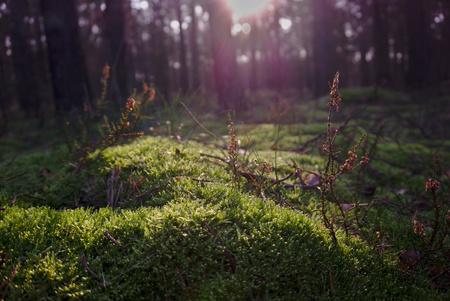Introduction to Ancient British Woodlands
Ancient woodlands are among Britain’s most treasured natural assets, providing a living link to the country’s ecological and cultural past. In the UK, a woodland is officially classified as ‘ancient’ if it has existed continuously since at least 1600 AD. This seemingly arbitrary date actually marks a significant point in British history—before widespread tree planting became common practice, meaning woods predating this era are likely to be naturally established ecosystems. These habitats are valued not just for their age, but for their exceptional biodiversity; many rare plants, fungi, insects, and animals rely on these stable environments, which have developed undisturbed over centuries. Beyond their ecological richness, ancient woodlands hold deep cultural significance, appearing in folklore, local traditions, and even shaping place names across the British landscape. Exploring these venerable woods is more than a walk through nature—it’s an encounter with living history and a chance to witness some of Britain’s most distinctive native trees in their original setting.
Understanding Native Tree Species
When exploring ancient British woodlands, it is crucial to understand what we mean by native species within the UK context. A native species is generally defined as one that has colonised and established itself in Britain without human intervention since the last Ice Age, around 10,000 years ago. These trees have co-evolved with local wildlife, fungi, and other plants, resulting in complex, resilient ecosystems unique to the British Isles.
Identifying native tree species matters for several reasons. Firstly, native trees support a far greater diversity of British wildlife than non-native or introduced species—everything from insects and birds to mammals and fungi rely on them for food and habitat. Secondly, ancient woodlands containing primarily native species are irreplaceable cultural landscapes, carrying centuries of history, folklore, and tradition. Protecting these areas preserves both biodiversity and heritage.
| Characteristic | Native Trees | Non-Native Trees |
|---|---|---|
| Origin | Evolved naturally in Britain post-Ice Age | Introduced by humans (e.g., for timber or ornament) |
| Wildlife Support | High; supports specialist British species | Often lower; some species cannot use them effectively |
| Cultural Significance | Rich in folklore and tradition | Generally less embedded in local culture |
| Ecological Impact | Integral to stable woodland ecosystems | May outcompete natives or alter habitats |
Recognising the difference between native and non-native trees is not only a matter of ecological interest but also practical conservation. When you learn to identify native species on your woodland walks, you become part of a broader effort to safeguard Britain’s natural legacy. This foundational knowledge informs responsible management decisions—from woodland restoration projects to everyday choices about planting in your own garden.

3. Key Native Trees and Their Features
Britain’s ancient woodlands are home to a remarkable diversity of native tree species, each with its own unique characteristics and seasonal changes. Here, we offer a practical guide for identifying some of the most iconic woodland trees—oak, beech, hazel, and holly—on your countryside rambles throughout the year.
Oak (Quercus robur and Quercus petraea)
The English oak is instantly recognisable by its broad, lobed leaves and rough, knobbly bark. In spring, look for fresh lime-green leaves and clusters of yellow catkins. By autumn, oaks bear distinctive acorns in scaly cups. Oaks are large, spreading trees; their strong limbs often support a rich community of lichens and mosses.
Beech (Fagus sylvatica)
Beech trees are elegant, with smooth grey bark that almost feels like elephant skin. Their glossy green leaves emerge in late spring with a slightly wavy edge. In autumn, beech woods glow golden-brown as the foliage turns, and you’ll find prickly husks containing shiny brown beechnuts carpeting the ground beneath mature trees.
Hazel (Corylus avellana)
Hazel is more of a shrub than a tree but forms an important part of woodland understoreys. In early spring, before leaves appear, look for long yellow catkins known as “lamb’s tails.” Hazel leaves are soft, rounded, and toothed along the edge. By late summer or early autumn, keep an eye out for clusters of edible hazelnuts—if the squirrels haven’t beaten you to them!
Holly (Ilex aquifolium)
A classic evergreen associated with British Christmas traditions, holly stands out all year round. Its dark green, glossy leaves are leathery and spiked at the margins—an effective deterrent against grazing animals. Female holly trees produce bright red berries in autumn and winter, providing vital food for birds when other resources are scarce.
Seasonal Identification Tips
Spring: Look for new leaves emerging and catkins on species like oak and hazel.
Summer: Observe leaf shape, arrangement, and texture; note the development of fruits or nuts.
Autumn: Identify trees by their seed cases—acorns on oaks, beechnuts under beech—and changing leaf colours.
Winter: Focus on bark patterns and silhouette; evergreen species like holly remain easy to spot amidst bare branches.
A Final Word
By learning these key features and tuning into subtle seasonal cues, you’ll enrich your woodland walks with the rewarding practice of tree identification—one of Britain’s oldest rural pastimes.
4. Walkers’ Guide: Spotting Trees on Your Ramble
For those setting out along Britain’s footpaths and bridleways, the chance to identify native trees is a rewarding part of any countryside ramble. Ancient woodlands are scattered across the UK, and every region has its own character and mix of native species. If you’re keen to recognise these living landmarks, timing and observation are key.
Best Times and Places for Tree Spotting
The diversity of British woodlands means you’ll encounter different species depending on where you roam. Early spring is excellent for spotting blossom and fresh leaves, while late autumn reveals distinctive bark and fallen seeds. Woodland edges, hedgerows, and stream banks often offer the greatest variety.
| Season | What to Look For | Recommended Locations |
|---|---|---|
| Spring | Buds, catkins, early leaves | Ancient woods, riversides |
| Summer | Mature leaves, flowers | Hedgerows, open woodland paths |
| Autumn | Fruits, nuts, colourful foliage | Parks with mature trees, forest clearings |
| Winter | Bark patterns, bare silhouettes | Open woodland glades, bridleways |
Distinguishing Features: What to Notice on Your Walks
Many native trees can be identified by a handful of telltale signs. The shape of leaves, texture of bark, and structure of branches are all useful clues. Don’t overlook seeds or nuts underfoot—acorns point to oak, while winged keys often signal ash or sycamore (though sycamore is not strictly native).
Top Tips for the Inquisitive Rambler:
- Carry a small field guide: Pocket-sized books tailored to British flora make on-the-spot identification easier.
- Pace yourself: Pause frequently; some features are easy to miss when walking briskly.
- Mind the canopy: Look up as well as around—the silhouette against the sky can be distinctive.
- Tread lightly: Stick to marked paths to protect delicate roots and saplings.
- Note local signage: Many ancient woodlands have informative boards describing notable trees nearby.
A Final Word on Respecting Woodlands
If you gather leaves or seeds for closer inspection, take only what you need and leave no trace. British woodlands are part of our shared heritage; enjoying them thoughtfully ensures they remain vibrant for generations of ramblers to come.
5. Cultural and Ecological Importance
Britain’s ancient woodlands are far more than just scenic landscapes; they are living chronicles of the nation’s cultural identity and ecological resilience. Native trees such as oak, ash, and yew have been woven into British heritage for centuries, forming the backbone of folklore, rural traditions, and even place names. The mighty oak, for instance, is a symbol of strength and endurance and features prominently in tales from Robin Hood to royal history. Similarly, the yew tree is often found in churchyards, associated with longevity and spiritual significance.
From an ecological perspective, these native species underpin entire woodland ecosystems. Oak trees alone can support hundreds of insect species, which in turn attract birds such as nuthatches, great spotted woodpeckers, and tawny owls. Bluebells create stunning carpets each spring beneath the ancient canopy, providing nectar for early pollinators. Badgers and foxes may be glimpsed at dusk, while deer quietly browse among the undergrowth.
On your woodland walk, you’re not only tracing the roots of Britain’s natural history but also witnessing the intricate relationships between trees and wildlife that have evolved over millennia. Every veteran tree and mossy stump is a microhabitat – home to fungi, beetles, bats, and countless lesser-seen creatures. By recognising and respecting these native trees, we honour their role in both our past stories and our present-day efforts to protect nature’s delicate balance.
6. Threats to Ancient Woodlands and Conservation Efforts
Ancient British woodlands are not only a treasure trove of biodiversity but also fragile ecosystems under considerable threat. Urban expansion, infrastructure projects such as new roads and railways, and agricultural intensification have all led to the fragmentation and loss of these irreplaceable habitats. Invasive non-native species like rhododendron and grey squirrels further disrupt native flora and fauna, while climate change introduces unpredictable stresses that can alter woodland dynamics.
Local communities and various organisations across the UK have recognised these challenges and are taking action. Groups such as the Woodland Trust, local Wildlife Trusts, and volunteer “Friends of” networks collaborate to monitor woodland health, remove invasive species, and campaign against harmful developments. Conservation efforts often focus on restoring natural woodland processes, for example by promoting natural regeneration of native tree species or managing deer populations to prevent overgrazing.
Many conservation projects also encourage public engagement—citizen science initiatives invite walkers to record sightings of rare trees or signs of disease, providing valuable data for ongoing research. Education programmes in schools and communities foster a sense of stewardship for ancient woodlands, ensuring that future generations appreciate their value.
The protection of ancient woodlands remains a complex challenge requiring persistent advocacy, practical management, and public awareness. By supporting conservation charities, participating in local woodland activities, or simply respecting footpaths during your walks, everyone can play a part in safeguarding these unique landscapes for years to come.
7. Getting Involved: What You Can Do
Exploring ancient British woodlands is not just about identification—it is also a call to action for those who cherish these habitats. There are several practical steps you can take during your woodland walks to help preserve these vital ecosystems and ensure their enjoyment for generations to come.
Leave No Trace
Always stick to designated paths to avoid trampling delicate ground flora, and take any litter home with you. Even biodegradable items, such as apple cores or orange peels, can disrupt the woodland ecosystem. Remember, what you bring in, you must also take out.
Respect Wildlife and Flora
Avoid picking flowers or disturbing wildlife. Use binoculars for birdwatching and keep a respectful distance from any animals you encounter. If youre identifying trees, refrain from peeling bark or breaking twigs—photographs and notes are preferable for your records.
Support Conservation Efforts
Consider joining local conservation groups or volunteering with organisations such as The Woodland Trust or National Trust. These groups often organise tree-planting days, guided walks, and habitat restoration projects which benefit both woodlands and communities alike.
Report Issues Responsibly
If you notice signs of disease (such as ash dieback), invasive species, or illegal activity like fly-tipping, report these observations to local councils or conservation bodies. Your vigilance helps maintain the health and safety of ancient woods.
Share Knowledge
Engage friends and family in your newfound appreciation for native trees. Sharing identification tips and encouraging others to explore responsibly fosters a wider culture of care and respect for Britain’s ancient woodlands.
By taking these thoughtful actions, each walk becomes more than just a personal journey—it becomes an investment in the future of our natural heritage.


